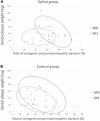Xylitol-Containing Chewing Gum Reduces Cariogenic and Periodontopathic Bacteria in Dental Plaque-Microbiome Investigation
- PMID: 35634392
- PMCID: PMC9131035
- DOI: 10.3389/fnut.2022.882636
Xylitol-Containing Chewing Gum Reduces Cariogenic and Periodontopathic Bacteria in Dental Plaque-Microbiome Investigation
Abstract
Background: Dental caries and periodontal disease remain the most prevalent oral health problems in the world. Chewing xylitol gum may help reduce the risk of caries and periodontitis for dental health benefits. However, little evidence has shown healthy food estimation by sequencing 16S rDNA in oral microbial communities. This study investigated the clinical effect of xylitol chewing gum on dental plaque accumulation and microbiota composition using the PacBio full-length sequencing platform in 24 young adults (N = 24). The participants were randomly assigned to xylitol chewing gum and control (no chewing gum) groups. Participants in the chewing gum group chewed ten pieces of gum (a total of 6.2 g xylitol/day). Dental plaque from all teeth was collected for weighing, measuring the pH value, and analysis of microbial communities at the beginning (baseline, M0) and end of the 2-week (effect, M1) study period.
Results: The results suggested a 20% reduction in dental plaque accumulation (p < 0.05) among participants chewing xylitol gum for 2 weeks, and the relative abundance of Firmicutes (a type of pathogenic bacteria associated with caries) decreased by 10.26% (p < 0.05) and that of Bacteroidetes and Actinobacteria (two types of pathogenic bacteria associated with periodontitis) decreased by 6.32% (p < 0.001) and 1.66% (p < 0.05), respectively. Moreover, the relative abundance of Fusobacteria was increased by 9.24% (p < 0.001), which has been proven to have a higher proportion in dental plaque of healthy adults. However, the dental plaque pH value stayed in a healthy range for the two groups.
Conclusion: In conclusion, chewing xylitol gum would benefit cariogenic and periodontal bacterial reduction in the oral cavity, which could help to prevent the diseases related to these bacteria.
Keywords: 16S rDNA sequencing analysis; dental caries (DMFT); dental plaque; oral health and hygiene; oral microbiota; periodontal health; periodontopathic bacteria; xylitol gum.
Copyright © 2022 Wu, Salamanca, Chen, Su, Chen, Wang, Sun, Teng and Chang.
Conflict of interest statement
The authors declare that the research was conducted in the absence of any commercial or financial relationships that could be construed as a potential conflict of interest.
Figures








References
-
- Yadav K, Prakash S. Dental caries: a microbiological approach. J Clin Infect Dis Pract. (2017) 2:1–15.
-
- Cronin M, Gordon J, Reardon R, Balbo F. Three clinical trials comparing xylitol-and sorbitol-containing chewing gums for their effect on supragingival plaque accumulation. J Clin Dent. (1994) 5:106–9. - PubMed
LinkOut - more resources
Full Text Sources

